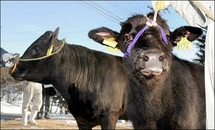
The researchers at Kinki University and Gifu's livestock research institute said they had cloned four Yasufuku calves between November 2007 and July 2008, although two of them died afterward.
"Yasufuku's testicles were frozen for a decade without any special treatment," the team said in a statement, calling it a breakthrough as specimens used for cloning are usually preserved carefully.
Japan has a variety of beef marketed as high-end. Ranchers sometimes massage the animals or feed them beer while they are being raised for slaughter.
A Japanese government panel is studying the safety of cloned beef and is reportedly leaning towards allowing it. US and European safety authorities last year gave the go-ahead for sales of food from cloned animals.
But the researchers said that for now they planned to use cloned animals to study what kinds of gene and protein structures make tasty beef rather than applying them directly to produce food.
Kinki University said it also hoped to advance an ambitious long-term project -- to restore extinct animals.
"Our dream is to create a mammoth, although it is a big dream," said Kazuhiro Saeki, professor at Kinki University.
To revive the huge Ice Age mammal, researchers would need to find a way to implant a cell nucleus into the egg of an elephant -- the mammoth's closest modern relative -- and then implant it into an elephant's uterus.
------------------------
Image of two cloned ox, from JIJI Press.
"Yasufuku's testicles were frozen for a decade without any special treatment," the team said in a statement, calling it a breakthrough as specimens used for cloning are usually preserved carefully.
Japan has a variety of beef marketed as high-end. Ranchers sometimes massage the animals or feed them beer while they are being raised for slaughter.
A Japanese government panel is studying the safety of cloned beef and is reportedly leaning towards allowing it. US and European safety authorities last year gave the go-ahead for sales of food from cloned animals.
But the researchers said that for now they planned to use cloned animals to study what kinds of gene and protein structures make tasty beef rather than applying them directly to produce food.
Kinki University said it also hoped to advance an ambitious long-term project -- to restore extinct animals.
"Our dream is to create a mammoth, although it is a big dream," said Kazuhiro Saeki, professor at Kinki University.
To revive the huge Ice Age mammal, researchers would need to find a way to implant a cell nucleus into the egg of an elephant -- the mammoth's closest modern relative -- and then implant it into an elephant's uterus.
------------------------
Image of two cloned ox, from JIJI Press.









 Home
Home Politics
Politics









